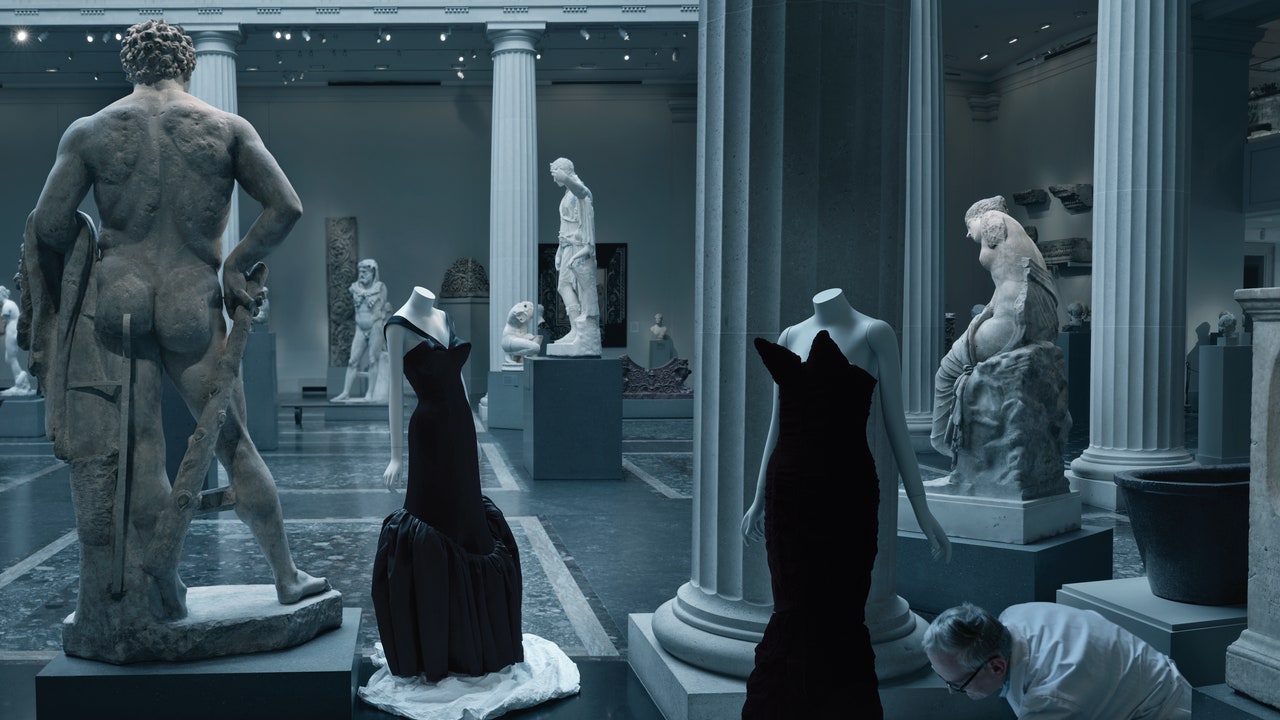The British stage designer Es Devlin has crafted monumental concert scenes for the likes of Beyoncé and Lorde as well as genius theater sets for Othello at The Met Opera and Hamlet at the Barbican, among others. Devlin’s newest work doesn’t star musicians or actors. After months of COVID-related delays, the exhibition she designed for About Time: Fashion and Duration opens at The Metropolitan Museum of Art’s Costume Institute. The show, which opens October 29, promises to be a sensory overload, with Meryl Streep, Julianne Moore, and Nicole Kidman reading Virginia Woolf’s Orlando and Devlin’s dramatic set design creating a clock-like pathway via which visitors can explore fashion’s shifting relationship to time. An animated preview of Devlin’s work—two interlocked clock-shaped galleries—makes its exclusive debuts here.
The decision to work with Devlin came naturally; she had designed several sets for Louis Vuitton’s womenswear collections in Paris, and with the time-traveling Nicolas Ghesquière as the exhibition’s co-chair, bringing on his collaborator felt right. “My favorite part of the job is collaborating with other creators outside of the curatorial field,” says Andrew Bolton, the Wendy Yu Curator in Charge of the Costume Institute. “I’ve been so lucky to work with these incredible creative people, and it really advances the narrative of the exhibition.”
He continues: “It’s always important to me that an audience enjoys the exhibition and it’s an experience for them, so we do try to offer these multisensory immersive experiences, where the installation in a way reinforces the narratives of the exhibition that we’re trying to convey. In this particular case we arrived at Es—I’d been a huge fan of hers and I thought I might work with her last year on Camp: Notes on Fashion, but we went in a different direction.”
That change of step for Camp proved serendipitous for About Time. Bolton has long had a fondness for the scene in the 1994 film version of Orlando, where Tilda Swinton, in the titular role, dashes through a hedge maze and emerges transformed through time and fashion. “I thought the idea of using a maze would be a good vehicle to convey this idea of time travel, and Es has done many mirror mazes, so she’s very familiar with the idea,” he explains. They spent a week working together on a maze concept in London pre-COVID, but then serendipity struck again. “I got a call from The Met saying that the New York Fire Department had shut the idea down because it was a fire hazard, if it was dead ends and people just couldn’t get out,” Bolton remembers. “I said, ‘Es, why don’t we just do a clock?’ Immediately, because Es is so creative, she just switched track, there was no sort of hesitation. She switched track and began working on this concept of a clock and oddly enough I think it’s better than it would have been originally.”
The final exhibit design is of two circular galleries that mimic a clock face, connected by a central darkened pathway. In the first gallery, time is presented linearly through pairings of garments arranged into a chronological timeline. At the gallery’s center is a pendulum, the ultimate reminder of the ticking of the clock, with Bolton’s 1870 to 2020 timeline of style located around the room’s perimeter. The figures seen here in the animation, quite Victorian in silhouette, nod to the pairings Bolton has made with the museum’s archives. Laying out the exhibition this way, he explains, not only emphasizes the importance of the museum’s collection and the strength of a linear view of fashion, but also celebrates a curatorial style The Met championed in the early ’90s. “I wanted to focus on what has been really one of our major contributions to the methodology of fashion curation over the years by focusing on this idea of juxtaposition. The first time we did it actually was in a show called Infra-Apparel in 1993, that’s the first time we employed that methodology,” he explains.
